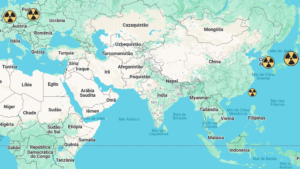- Digital standards are like rules that guide technological creation and shape geopolitical dynamics;
- The competition between global powers for control of digital standards transcends technology, becoming a strategy where nations seek to dictate standards to boost their industries;
- Countries that dictate digital standards, or other standards, have greater bargaining power and influence over other nations.
In the era of the digital revolution, where technology plays a central role in all aspects of society, the issue of digital standards emerges as a crucial geopolitical element.
The geopolitical importance of establishing global standards highlights not only its relevance in the technological field, but also its influence in several other areas, from trade and health to national security and human rights, making this a fact to be analyzed from a comprehensive view of the geopolitical role played by digital standards in the configuration of the contemporary digital world.

What are digital standards and how are they established?
Digital standards are like rules that help create technologies. They ensure that different devices and software can work together optimally. Here are some reasons why these standards are so important:
- Cooperation: Digital standards make it easier for different technologies to work together. This is important so that our devices and applications can work. Thanks to standards like HTML5, CSS and JavaScript, for example, developers can create applications that work on multiple platforms, such as iOS and Android, allowing users to use the same applications on different devices.
- Quality: Following standards makes technologies more reliable and consistent. That means fewer mistakes and better products. One example is the audio and video coding standard known as MPEG-4. By following this standard, digital media products such as DVD players and video editing software ensure a consistent and reliable experience for users, regardless of the device or software used.
- Innovation: Standards provide a foundation for innovation. They help developers create new things instead of spending time solving problems. One example is the development of augmented reality (AR) and virtual reality (VR) technologies is driven by the use of open standards such as OpenXR. This standard provides a common foundation for developing AR/VR applications, allowing developers to create innovative immersive experiences without worrying about compatibility across different devices and platforms.
- Saving Resources: Following standards helps companies save time and money, as they do not need to create multiple solutions frequently. This makes everything more efficient. A practical example is companies that adopt document management standards, such as PDF (Portable Document Format), can save time and resources by avoiding the need to convert documents between different formats. This results in greater operational efficiency and reduced costs associated with maintaining multiple document management systems.
- Security: Digital standards often include rules for keeping systems safe from online threats. They also take care of user privacy. As an example, the TLS (Transport Layer Security) security standard is essential for protecting online communications, ensuring the privacy and integrity of data transmitted over the Internet. By following TLS specifications, developers can implement strong encryption and protection against cyberattacks, keeping users’ systems and data safe.
- Adapting to Change: Standards-based technologies are easier to change as needs change. They can handle more data, users or devices well. Container technology, based on standards like Docker and Kubernetes, allows organizations to deploy and manage applications in a flexible and scalable way. They are like special boxes where you can put an application and all its necessary things to work. These boxes can be easily moved from one place to another, such as from a computer to the cloud. This helps companies be more flexible because they can place their applications where they are needed most and make them work better when more people are using them.
- Easy Acceptance: Widely accepted industry and community standards make it easier for everyone to adopt new technologies. The TCP/IP communication protocol, for example, is an example of a widely accepted standard that facilitates the adoption of networking technologies around the world. Thanks to this standard, network devices from different manufacturers can communicate with each other efficiently, facilitating the expansion and interconnection of Internet infrastructure on a global scale.
- Global Competition: In a globalized world, following standards helps to participate in different markets around the world. Products and services that follow standards are more accepted in different regions. The use of video coding standards such as H.264 and H.265 allows video streaming companies to deliver high-quality content in different regions of the world. By following these standards, companies can reach a global audience without the need to adapt their content to different video formats, making them more competitive in the global digital media market.
How global digital standards are established:
- International Collaboration: Global standards do not emerge in isolation. They are shaped by international collaboration, involving experts, organizations and even governments from different countries.
- Standardization Organizations: Many standards are developed by specialized organizations, such as ISO (International Organization of Standardization) and the IEEE (Institute of Electrical and Electronic Engineers), which bring together professionals from all over the world.
- Specific Sectors: In technology, consortia and organizations dedicated to specific areas, such as 3GPP for telecommunications, play a crucial role in formulating standards.
- Technical Discussions: Setting standards involves detailed technical discussions by experts who seek to ensure that standards are robust and relevant.
- Iteration and Consensus: The process often goes through several iterations, refining standards as they are tested and revised. Consensus is critical to ensuring global acceptance.
- Gradual Implementation: Once established, standards are gradually implemented by companies and organizations around the world, creating a common foundation for products and services.
In short, digital standards are like rules that help create better, safer and more efficient technologies. They are key to driving innovation and improving digital progress in various areas.
China’s growing influence on international digital standards
Amid the constant changes of the digital revolution, China appears to be a prominent actor, not only in the production of technology, but also in defining digital standards.
This influence manifests itself in standards-shaping International Organizations, such as the International Telecommunications Union (ITU) and the 3rd Generation Partnership Project (3GPP). In these forums, the active participation of Chinese companies, such as Huawei, has been notable. The Chinese presence is strategic and raises questions about how this could impact the technology market, given the competition with the United States and the European Union.
An example of this was the race for dominance in the implementation of 5G technology. This “geopolitical moment” in the digital transition highlights not only technological competition, but also the battle for regulatory influence, just as the European Union has the ability to spread Regulatory Frameworks around the world.
China’s role in setting standards for facial recognition and surveillance technologies is also in focus. His leadership of bodies such as the International Electrotechnical Commission (IEC) raises concerns about the balance between technological innovation and individual rights.
This is because the Beijing government has been criticized for state control and surveillance, lack of transparency and potential misuse of data.
Digital Standardization as Bargaining Power and “Carrot and Stick” Strategy in Geopolitical Relations
The intense competition between global powers such as the United States, China and the European Union, for control of digital standards, transcends the technological field, influencing geopolitical dynamics in a world where standardization represents power.
The race to establish standards is not limited to technology; has become an influential strategy where nations realize that dictating these standards not only boosts their industries but leaves a lasting mark on the world stage.
In this context, the concept of Soft Power, the subtle ability that countries may have to influence other countries or regions without resorting to direct military or economic forces, comes into action. Those who set the standards have the benefit of guiding technological innovation and influencing geopolitical relations in favor of their visions and interests.
As mentioned, China is emerging as a power in this dispute, not only dominating technologically, but seeking to establish a global voice of impact.
This quest represents a crucial confrontation in terms of global influence, challenging the central role that the United States has historically played in defining technological standards, giving it commercial advantages and a prominent position in global geopolitics.
The European Union, for its part, adopts a consumer-centric approach to data protection, aligning its standards with its fundamental values. For the EU, which already dominates the standards of regulatory frameworks, this competition transcends the commercial sphere, being an initiative to shape a digital future that reflects its priorities and concerns.
As an example, these are some ways in which “Carrot and Stick” can be used in geopolitical relations:
- Access to the Global Market:
- Carrot: Countries can offer preferential access to dominant markets in exchange for the adoption of established digital standards.
- Stick: These countries can also impose trade barriers or access restrictions if the standards are not followed, limiting trade and economic development.
- Technical and Financial Assistance:
- Carrot: Countries can provide technical and financial assistance for the implementation of standards, including training, infrastructure financing, and capacity building.
- Stick: These same countries can suspend benefits in case of non-compliance, hindering development and modernization efforts.
- Foreign Direct Investment (FDI):
- Carrot: Countries can offer favorable conditions for foreign direct investment as a reward for adopting standards.
- Stick: Similarly, countries can also deter investors due to non-compliance, harming FDI inflows and economic development.
- Cooperation in Global Projects:
- Carrot: By using standards, countries can be included in significant global projects, promoting international cooperation and global recognition.
- Stick: Conversely, non-standardized countries may be excluded from international cooperation, limiting their participation and associated benefits.
- Technological Capacity Building:
- Carrot: Countries with cutting-edge technology can transfer that technology and advanced knowledge to nations that follow the standards, accelerating their technological development.
- Stick: Likewise, they can restrict access to advanced technologies for non-compliant entities, hindering technological progress.
- Access to Resources and Research Collaboration:
- Carrot: Countries can facilitate access to natural resources and research collaboration as an incentive for compliance.
- Stick: Conversely, these countries can also restrict access to resources and collaboration for those who do not adhere to the standards, harming key sectors.
- Cybersecurity Training and Data Protection:
- Carrot: Countries with high technology can offer training and support in cybersecurity to compliant countries.
- Stick: The lack of standardization in some countries can also result in increasing vulnerabilities, with risks of cyberattacks and data loss.
- International Recognition and Participation in Organizations:
- Carrot: Standardization can grant international recognition and participation in global organizations as benefits for compliant countries.
- Stick: Alternatively, the lack of standardization can diplomatically isolate countries and exclude those who do not adhere to the standards from international organizations.
8 Other Areas That Can Be Affected by the Establishment of Global Standards
The establishment of global standards is not limited only to technology but is a crucial strategy in various other areas. Here are some examples where standardization plays an important role from a geopolitical perspective:
- Trade and Economy: Standards related to trade norms, product quality, and manufacturing processes directly impact international trade. Countries that influence these standards can exert considerable power over global supply chains. An example is the ISO 9000 standard, which sets criteria for quality management systems in organizations of all sectors and sizes. ISO 9000 certification indicates that a company follows rigorous quality standards in its manufacturing and management processes, ensuring consistency and reliability of its products.
- Health and Well-being: Standards in the pharmaceutical industry, medical practices, food regulations, and food safety are areas where standards can affect global health. Countries that dictate these standards can influence the acceptance of their products and practices. A global example is the role of the World Health Organization (WHO) in setting standards and guidelines for medical practices and public health regulations. WHO establishes international standards for disease control, vaccination, food safety, and other global health issues.
- Environment and Sustainability: Standards related to emissions, energy efficiency, waste management, and sustainable practices have significant implications for the environment. Countries that lead in defining these standards can shape the global sustainability agenda. The Kyoto Protocol is an example of an international standard that sets goals for reducing greenhouse gas emissions. Countries adhering to these standards contribute to global efforts to mitigate climate change and influence the global sustainability agenda.
- Education and Professional Qualifications: An additional example is the European Union’s (EU) European Credit Transfer and Accumulation System (ECTS), which establishes standards for the recognition of academic and professional qualifications among EU member countries. This system facilitates the mobility of students and professionals among EU countries, ensuring that their qualifications are recognized and accepted throughout the European Union.
- Legal Standards and Human Rights: In the legal and human rights field, standards related to justice, protection of individual rights, and ethical norms can be established internationally. Countries playing an active role in these areas shape the global perception of justice and rights. The Universal Declaration of Human Rights is an example of an international standard that establishes basic principles of justice and human rights. Countries adopting and promoting these standards influence the global perception of individual rights and government accountability.
- Telecommunications and Infrastructure: Standards in telecommunications, communication networks, and infrastructure are critical for global connectivity. Countries or companies that lead in defining these standards can exert influence over the expansion of digital infrastructure worldwide. The Global System for Mobile Communications (GSM) standard is widely adopted in mobile telephony worldwide. Countries and companies that have contributed to the development and adoption of this standard influence the expansion of global mobile communication infrastructure.
- Transportation and Logistics: Standards in transportation, logistics, and safety regulations have implications for global trade and the movement of goods. Countries that influence these standards can determine the conditions of international transportation. The International Civil Aviation Organization (ICAO) sets standards for safety and regulation of international civil aviation. Countries adhering to these standards contribute to the safety and efficiency of global air transportation.
- Cybersecurity and Information Security: Standards related to cybersecurity, data protection, and information security practices are crucial in the digital age. Countries that establish standards in this field can influence global security in the digital sphere. The Payment Card Industry Data Security Standard (PCI DSS) defines requirements to protect payment card information against theft and fraud. Companies adhering to this standard contribute to the global security of online financial transactions.
These areas represent just a sample of the many in which standardization plays a fundamental role, highlighting the diversity of sectors in which standards can be employed as geopolitical tools.
Why Is Mastery of Digital Standardization Important for Geopolitics?
In addition to bargaining power and influence over other countries, standardization in general has several other significant geopolitical consequences. Countries or blocs that establish digital standards can strengthen their position on the global stage, securing a competitive advantage in key sectors such as artificial intelligence, 5G, cybersecurity, among others.
This control also provides significant economic advantages for local companies, as they do not need to invest financial resources in adapting to new standards, unlike foreign companies that may face additional costs to comply or even have to import technology to meet the requirements of established standards.
On the other hand, a lack of consensus in standardization can lead to a digital divide, where different regions adopt incompatible standards, creating trade barriers and hindering global interoperability.
Additionally, countries that lead in defining standards have greater influence over the direction of global technological innovation and the economy as a whole, driving economic development and influencing areas such as digital ethics, privacy, and security.
Digital standardization can also impact information control and global surveillance, raising questions about privacy and data governance. Reflecting cultural values and norms, digital standards can be a tool for exporting cultural perspectives and influencing how technology is used in different parts of the world.
National security and cybersecurity are also areas where digital standards play a crucial role, providing advantages in terms of protection against cyber threats and ensuring the integrity of sensitive systems such as government ones.
In conclusion, these consequences highlight the complexity and breadth of the geopolitical impact associated with digital standardization, extending far beyond purely technological considerations.






















Be First to Comment